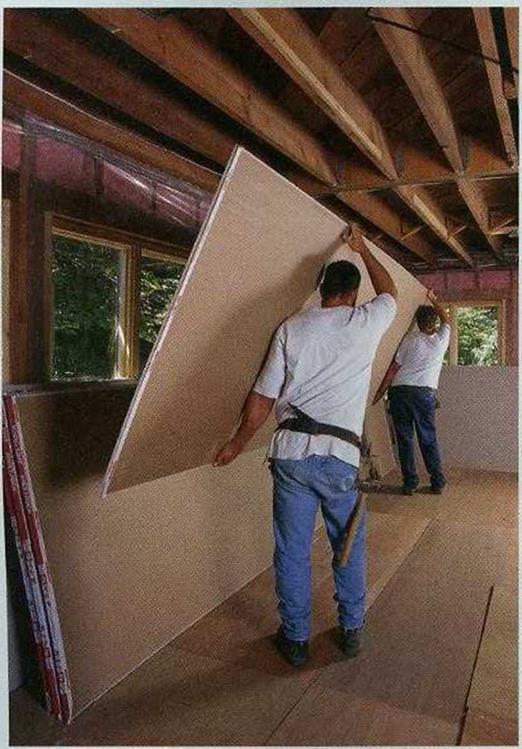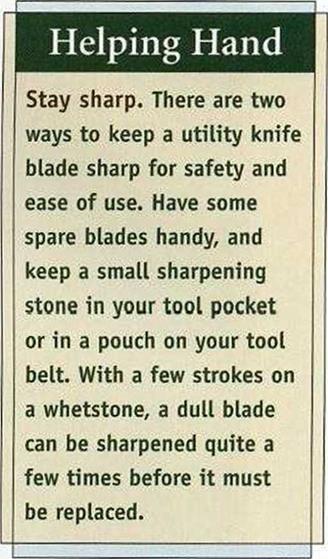Ordering Drywall and Associated Supplies

LIKE SHINGLES, SIDING, and insulation, drywall amounts are calculated by the square footage of the area to be covered (in this case, the walls and ceilings). Rather than measuring the ceiling and walls in every room, experienced drywallers use a shortcut calculation. They simply multiply the total square footage of a house by 3!! (3.5). For instance, a 24-ft. by 36-ft. house has 864 sq. ft. of floor space, and 864 times 3.5 equals 3,024 sq. ft. of drywall coverage.
DRYWALL IS HEAVY! Carrying a long sheet, like this 12 footer, is definitely a two-person job.
[Photo ® The Taunton Press, Inc.]
Your drywall order
For the modest-size houses that Habitat builds, it s best to make up most of your drywall order with 12-ft. drywall panels. A 4×12 sheet of dry – wall is more difficult to carry than a 4×8 sheet, but it covers more area and often eliminates the need for butt joints on a wall or ceiling. To fine – tune your drywall order, subtract any greenboard you will be using in the bathroom. Also, if you decide to go with %-in. drywall on the ceiling, subtract the floor area (864 sq. ft. in our example) from the square-foot total, then order that amount of %-in. dry – wall for the ceiling.
Have the drywall delivered several days before you plan to hang it. If you’re using any %-in. drywall, stack those sheets on top of the %-in. sheets. Storing all the drywall in one room creates a lot of weight on a few floor joists. Therefore, make a neat pile in each room, with the drywall flat on the floor, finish side facing up.
Screws and nails
Professional drywall hangers rarely use drywall nails. Screws hold better than nails, and a screw gun automatically drives the screws just the right distance, dimpling the drywall surface without breaking the paper.
If you’re not a seasoned drywall hanger, you’ll probably find it useful to drive a few nails to hold a panel in place against the studs or ceiling joists. Then you can finish installing the panel with screws. A 5-lb. box of dry – wall nails and a 50-lb. box of l!4-in. drywall screws should give you all the fasteners you need for a l,200-sq.-ft. house. If you’re hanging %-in.-thick panels, order 1 %-in.-long fasteners.
Joint tape, corner beads, and drywall compound
You can order these finishing supplies when you order your drywall. Joint tape comes in rolls; order 400 ft. for every 1,000 sq. ft. of drywall.
Every outside corner covered with drywall requires a corner bead. These steel or plastic trim pieces are typically sold in 8-ft. or 10-ft. lengths. When estimating the amount of bead to order, make sure you account for corners where drywall wraps around window and door openings.
As far as drywall compound goes, the typical Habitat house requires about nine 5-gal. buckets. For the Charlotte house, we used an all-purpose compound called Durabond®, which comes in powdered form and is mixed with water at the job site. Other folks prefer to buy premixed compound, which comes in buckets or boxes.

UTILITY KNIVES AND SPARE BLADES. Most straight cuts in drywall are made with a utility knife. Have a good supply of new blades handy. A sharp blade cuts cleanly through a panel’s paper facing, while a dull blade can tear the paper.
DRYWALL SQUARE. This large, aluminum, T-shaped square enables you to quickly and easily make straight, square cuts in drywall.
SCREW GUN. A screw gun takes the guesswork out of fastening drywall because it sinks dry- wall screws just the right distance into the panel. This tool resembles an electric drill and holds a replaceable Phillips-head bit.
DRYWALL HAMMER. This hammer looks like a small hatchet with a convex hitting surface.
The curved face allows you to set the nail below the surface of the drywall without breaking the paper. The hatchet end is not sharp and can be used for levering or wedging drywall into place.
SURFORM® TOOL. Designed to function like a handplane, this shaping tool is very useful for trimming small amounts off the edge of a panel to improve its fit on the wall or ceiling. Avoid large Surform tools; the smaller versions are more maneuverable and fit in a pouch on your tool belt.






Leave a reply